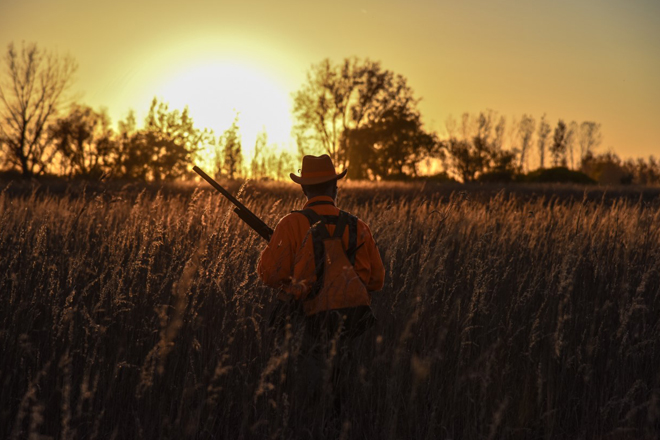A little scouting time from treestand or truckseat goes a long way toward a gamebag graced with roosters
Story by Richard Massey, Photos by Will Massey
You know the drill if you’re a pheasant hunter. The season begins with dreams of the gaudy bird rising before you. Without missing a beat you shoulder the shotgun and drop him with one shot.
Then reality sets in. You’re walking good cover and the dog’s working hard but there’s nothing there. If you’re a “seasoned” pheasant hunter like me, you even know what’s wrong: It’s early season and the birds are in standing corn.
Then what are you doing there, you ask? Tradition. It’s opening day for gosh sakes and we have to be there, don’t we?
Actually, no, we don’t. In the good old days, it wasn’t such a problem. Yes, the birds were still in the standing corn back in the good old days too. But there was a difference back then. The birds weren’t different. The corn was.
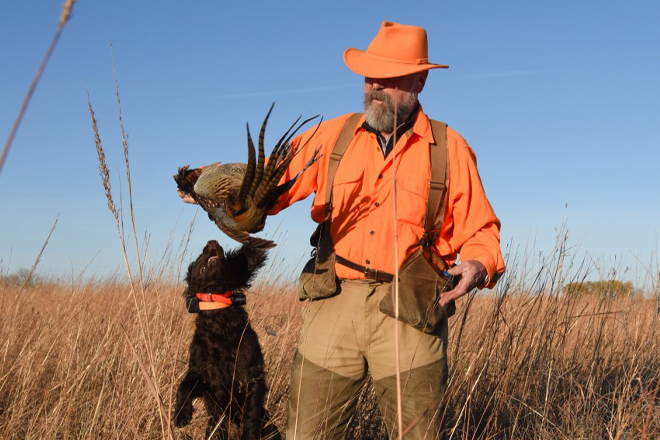
In the good old days, openers were all about corn. Why? As is often the case, with pheasant hunting, it comes down to farming practices. The width between corn rows back then allowed you to walk down the field with ease. It was weedy too, which the birds liked.
You’d walk along and watch the pheasants ahead of you legging it down the rows. Dogs weren’t so necessary then. The birds heard you coming when the dry stalks rustled.
You’d have no luck with that hunt these days. The corn rows are so close together you’d have trouble trying to shuffle through sideways. And no farmer would want you in his field knocking down his crops.
Besides, there’s a better way to get your early season ringneck. It even requires less work than pheasant hunters are used to. It’s a matter of scouting and timing. Here’s how it works for me.
SCOUTING RECON
To start, I go bowhunting. My tree stands are strategically located. As I wait for deer to come by, I’m also within view of some Conservation Reserve Program (CRP) fields, prime habitat or good public uplands, next to standing corn. The birds stay in standing corn all day; but in late afternoon they come sailing out of the corn and into grass for the night.
What a sight to see. And you don’t have to be a bowhunter to find your own trove of ringnecks by scouting from your vehicle. That way, you can camp out a long way from the cover but next to the corn. Using binoculars, you won’t be close enough to alarm birds as they travel and then settle in for the night.
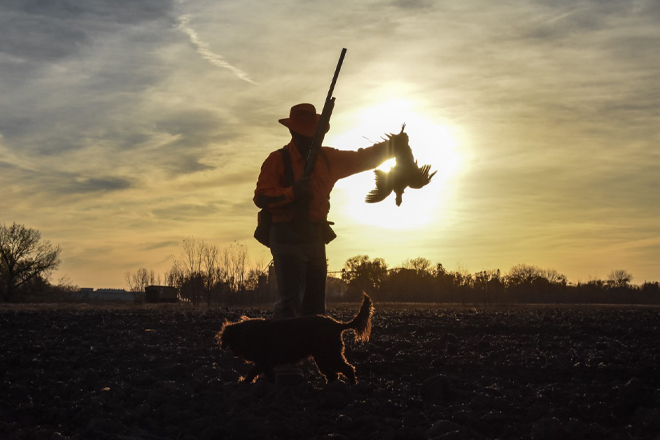
If the scenario satisfies you, then watch the clock and you’ll know when to show up the next day or when the pheasant season opens. It’s a limited time opportunity as the TV marketers say. You just need to be there ahead of flight time. How far ahead? In my experience, a half hour before flight time will be about right.
HUNTING REWARDS
So there we were. Tomorrow couldn’t come soon enough. When I climbed down from the tree it was time to assemble the troops for the hunt.
Besides me, there’d be two other able guns in that field: my childhood buddy Steve Aagesen and his wife Sue. They guide me to some great duck hunting every year, so I owed them a pheasant opportunity.
In addition to the extra guns, they are lucky to have a great yellow lab named Star that would join my American Water Spaniel, Pal. Pal was only six months old at the time, so this hunt could prove to be “interesting.”
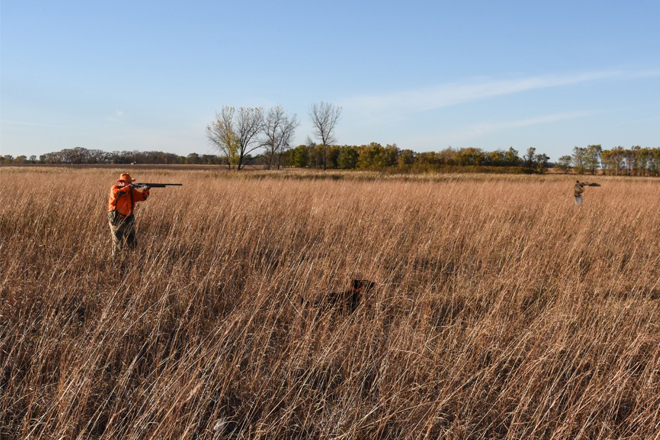
We were no more than a few steps into the prairie grass when birds started jumping. The bird -in-the-hand rule is a strong one, and we all raised a gun. But because we were all veteran hunters, we all chose to stick with the plan. If it worked, we’d have birds landing all around us instead of shooting one and spooking away a dozen others.
It was nearly go-time. The three of us spread out in the cover a bit and took a knee to lower our profile.
Then it happened. No need to rush this. By the clock we had a good 20 minutes before official dark. What a sight! Big red birds were what we were looking for, and they came sailing in with the hens. When the flight in was over we unleashed the dogs and went to work.
The two dogs took off together. Young Pal was stuck to Star like a burr in her coat. They followed the scent and a ringneck jumped just ahead. One or both Aagesens dropped that bird nicely. Star delivered up a 2-year old fowl, judging by his long spurs. The dogs picked up more scent and were off again, plodding through the bluestem.
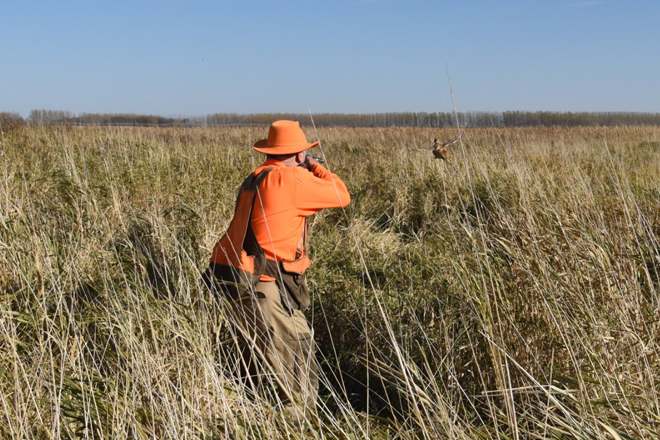
The next cock up nearly escaped after busting out right at my feet. I was able to control my emotions enough to pull the gun from the tall grass at last and drop the bird.
I was feeling pretty good about the shot and felt even better when I saw Pal coming to me with his first retrieve! Since he was just a puppy, I could forgive him when he walked right by me with “his” bird.
When the next rooster jumped it was Sue who brought the bird down handily with her 20-gauge. Star had no problem bringing the bird to “mommy.” In fact, Star brings every bird to mommy. That’s OK by Steve. That dog is so good she can do what she wants, and what she wants is a nose full of pheasant scent.
Then we headed back toward the road. Your local road hunter could tell you why we did that. Right before sundown birds and road hunters converge on roadsides. Pheasants are there to pick grit that grinds the grain in their crops. Road hunters are there because they know about that need. By the time DNR sundown arrived we happy hunters had a limit of roosters apiece.
A look at our watches told us the golden-hour hunt was done. With a beer and a Romeo and Julietta cigar in hand, I joined my friends in a toast to a glorious October sunset and a glorious hunt.
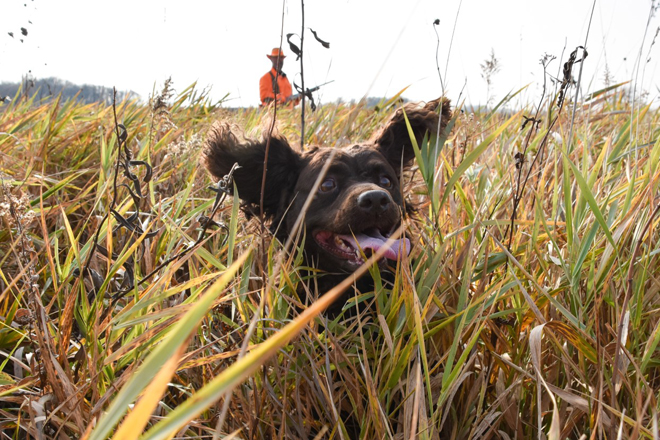
As we all know, not every hunt works out like it’s supposed to. But this one had. We were all happy with the dogs’ performances. Especially me. Pal the puppy was all I was hoping for. He was aggressive, but not insanely so. Just right. The training collar was there only to make sure he didn’t get carried away.
As my son Will (who was along with a camera) remarked when he had put the Nikon away: We 3 old farts had indeed been lucky that day.
ROOSTER TRADITIONS
It would be so nice if that afternoon’s kind of hunting luck could be had every day. But of course no, it can’t.
What can be had every day of the pheasant season, though, is the chance to pursue our favorite gamebird and enjoy the dog work that keeps alive the spirit of the hunt in the hearts of all us sportsmen and women. Especially we seniors.
We intend to hobble after roosters as long as we can, and spread the word that there’s plenty of public hunting land still out there to explore if you have the ambition. It’s up to all of us who love pheasants to work for habitat and donate generously to keep it so.
Remember. One day you’ll be retired and every day will be Saturday … another Saturday to hunt.
Richard Massey taught English for 38 years, wrote about the outdoors and hosted Prairie Sportsman TV before “retiring” to hunting and fishing in his native western Minnesota. This story first appeared in the Summer Bird Dogs Issue of Pheasants Forever Journal.
